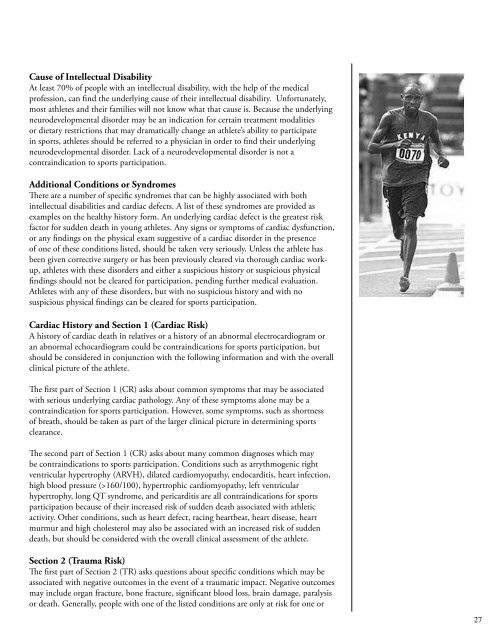MedFest Manual for Clinical Directors - Special Olympics
MedFest Manual for Clinical Directors - Special Olympics
MedFest Manual for Clinical Directors - Special Olympics
Create successful ePaper yourself
Turn your PDF publications into a flip-book with our unique Google optimized e-Paper software.
Cause of Intellectual Disability<br />
At least 70% of people with an intellectual disability, with the help of the medical<br />
profession, can find the underlying cause of their intellectual disability. Un<strong>for</strong>tunately,<br />
most athletes and their families will not know what that cause is. Because the underlying<br />
neurodevelopmental disorder may be an indication <strong>for</strong> certain treatment modalities<br />
or dietary restrictions that may dramatically change an athlete’s ability to participate<br />
in sports, athletes should be referred to a physician in order to find their underlying<br />
neurodevelopmental disorder. Lack of a neurodevelopmental disorder is not a<br />
contraindication to sports participation.<br />
Additional Conditions or Syndromes<br />
There are a number of specific syndromes that can be highly associated with both<br />
intellectual disabilities and cardiac defects. A list of these syndromes are provided as<br />
examples on the healthy history <strong>for</strong>m. An underlying cardiac defect is the greatest risk<br />
factor <strong>for</strong> sudden death in young athletes. Any signs or symptoms of cardiac dysfunction,<br />
or any findings on the physical exam suggestive of a cardiac disorder in the presence<br />
of one of these conditions listed, should be taken very seriously. Unless the athlete has<br />
been given corrective surgery or has been previously cleared via thorough cardiac workup,<br />
athletes with these disorders and either a suspicious history or suspicious physical<br />
findings should not be cleared <strong>for</strong> participation, pending further medical evaluation.<br />
Athletes with any of these disorders, but with no suspicious history and with no<br />
suspicious physical findings can be cleared <strong>for</strong> sports participation.<br />
Cardiac History and Section 1 (Cardiac Risk)<br />
A history of cardiac death in relatives or a history of an abnormal electrocardiogram or<br />
an abnormal echocardiogram could be contraindications <strong>for</strong> sports participation, but<br />
should be considered in conjunction with the following in<strong>for</strong>mation and with the overall<br />
clinical picture of the athlete.<br />
The first part of Section 1 (CR) asks about common symptoms that may be associated<br />
with serious underlying cardiac pathology. Any of these symptoms alone may be a<br />
contraindication <strong>for</strong> sports participation. However, some symptoms, such as shortness<br />
of breath, should be taken as part of the larger clinical picture in determining sports<br />
clearance.<br />
The second part of Section 1 (CR) asks about many common diagnoses which may<br />
be contraindications to sports participation. Conditions such as arrythmogenic right<br />
ventricular hypertrophy (ARVH), dilated cardiomyopathy, endocarditis, heart infection,<br />
high blood pressure (>160/100), hypertrophic cardiomyopathy, left ventricular<br />
hypertrophy, long QT syndrome, and pericarditis are all contraindications <strong>for</strong> sports<br />
participation because of their increased risk of sudden death associated with athletic<br />
activity. Other conditions, such as heart defect, racing heartbeat, heart disease, heart<br />
murmur and high cholesterol may also be associated with an increased risk of sudden<br />
death, but should be considered with the overall clinical assessment of the athlete.<br />
Section 2 (Trauma Risk)<br />
The first part of Section 2 (TR) asks questions about specific conditions which may be<br />
associated with negative outcomes in the event of a traumatic impact. Negative outcomes<br />
may include organ fracture, bone fracture, significant blood loss, brain damage, paralysis<br />
or death. Generally, people with one of the listed conditions are only at risk <strong>for</strong> one or<br />
27

















